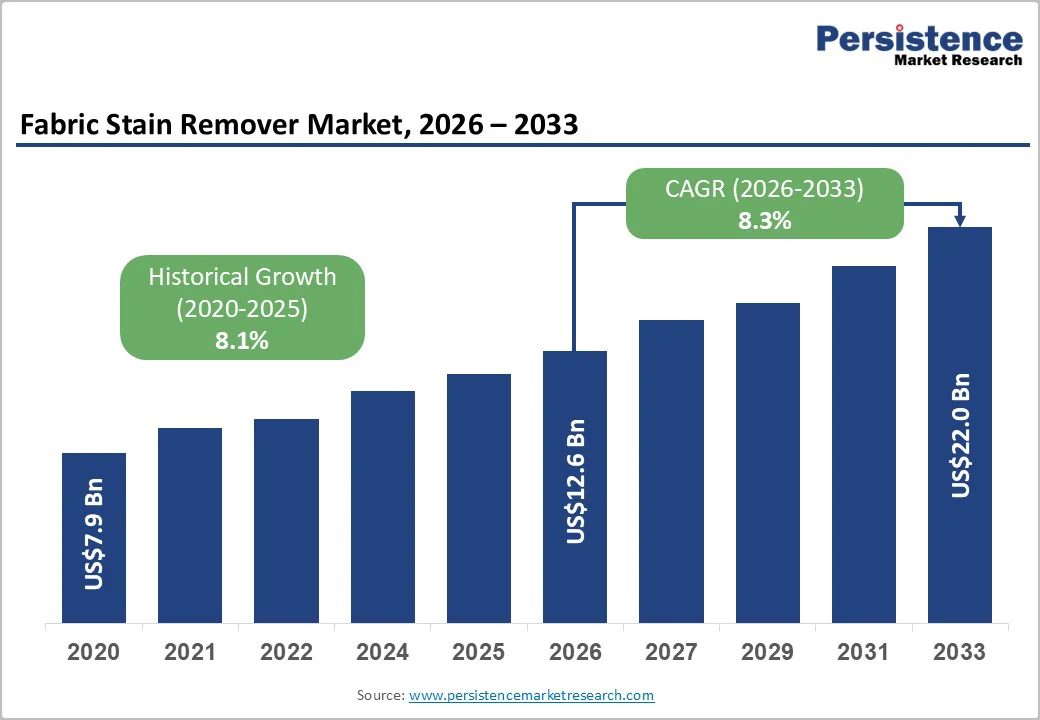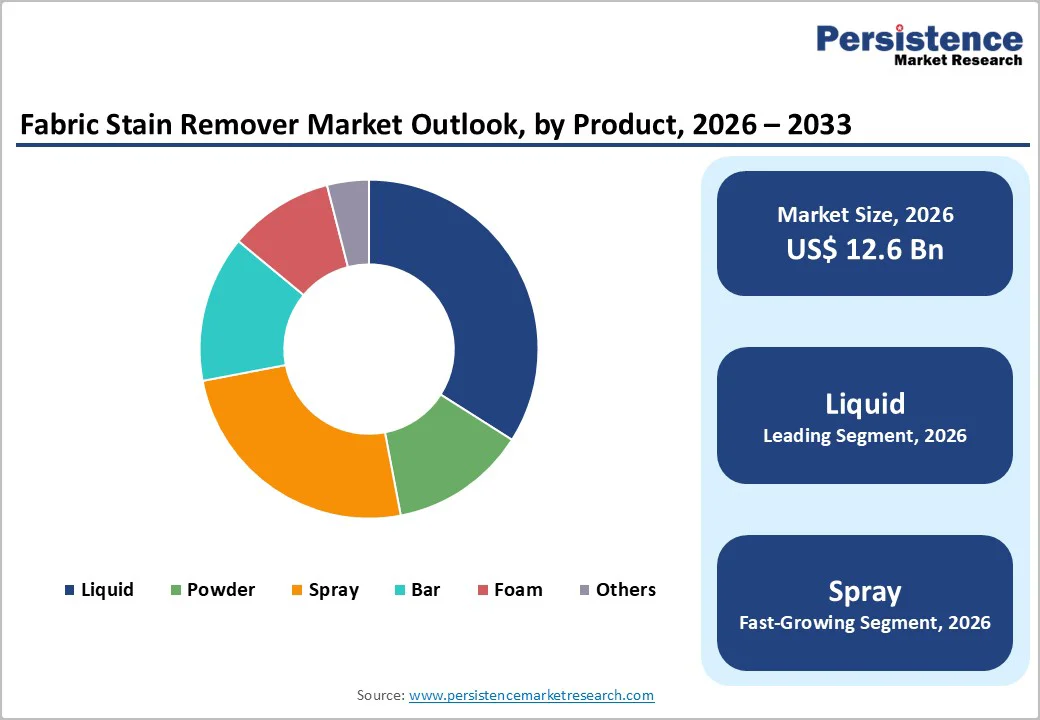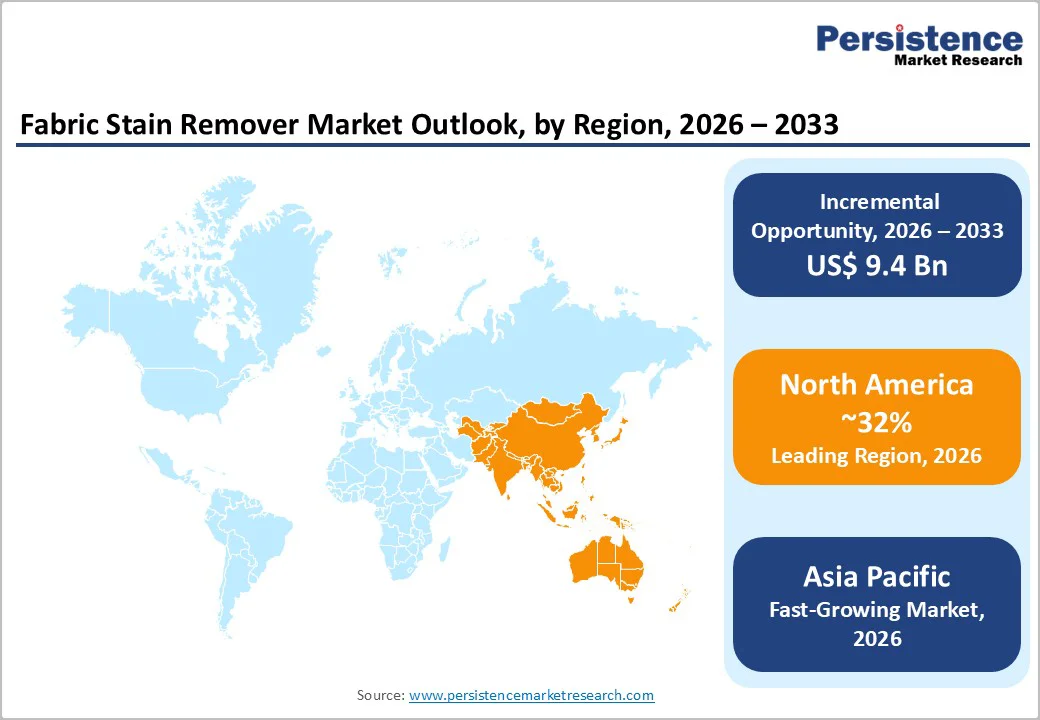ID: PMRREP34197| 189 Pages | 17 Dec 2025 | Format: PDF, Excel, PPT* | Consumer Goods

The global fabric stain remover market size is likely to be valued at US$12.6 billion in 2026 and is expected to reach US$22.0 billion by 2033, growing at a CAGR of 8.3% during the forecast period from 2026 to 2033, driven by increasing consumer preference for effective, fast-acting stain removal products and rising awareness about fabric hygiene, particularly in rapidly urbanizing regions.
Companies are prioritizing eco-friendly, plant-based, enzymatic, and biodegradable formulations to meet stricter environmental regulations and rising consumer demand for sustainable cleaning solutions. Convenient formats such as sprays, foams, stain-removal pens, and concentrated liquids are gaining traction, while rising disposable incomes in emerging markets and expanded e-commerce access further boost adoption.
| Key Insights | Details |
|---|---|
|
Fabric stain remover market Size (2026E) |
US$12.6 Bn |
|
Market Value Forecast (2033F) |
US$22.0 Bn |
|
Projected Growth (CAGR 2026 to 2033) |
8.3% |
|
Historical Market Growth (CAGR 2020 to 2025) |
8.1% |

Growing hygiene consciousness is a major driver of the fabric stain remover market, as consumers increasingly prioritize cleanliness, fabric care, and germ-free living environments. Post-pandemic behavioral shifts have heightened awareness of laundry hygiene, prompting more frequent washing cycles and stronger demand for specialized stain-removal solutions. Households with children, working professionals, and pet owners now rely on targeted cleaners to handle food spills, sweat marks, ink stains, and outdoor dirt. Marketing campaigns promoting fabric safety and long-lasting freshness are fueling household consumption, particularly in regions with high pollution and humidity, where clothing gets soiled more easily.
Urban lifestyles amplify this demand as modern consumers seek convenience-oriented products that fit fast-paced routines. Growing urbanization in Asia, Latin America, and Africa, with millions moving to cities annually, drives higher usage of ready-to-use formats such as sprays, sticks, and liquid concentrates. Busy urban households favor quick-acting solutions that work across multiple fabrics, while rising apartment living increases reliance on efficient laundry care systems. The popularity of on-the-go stain remover pens in metropolitan markets like Tokyo, New York, and Shanghai illustrates how urban mobility directly accelerates category growth.
Stringent regulations governing chemical ingredients in cleaning and laundry care products have become a significant restraint for the fabric stain remover market. Governments across major economies including the U.S., EU, and China, are tightening safety standards for surfactants, phosphates, optical brighteners, solvents, and preservatives commonly used in stain-removal formulations. Compliance with frameworks such as the U.S. EPA Safer Choice Program, EU REACH, and various national eco-labeling schemes requires manufacturers to reformulate products, invest in safer alternatives, and perform extensive toxicology testing.
Restrictions on volatile organic compounds (VOCs) and microplastics in detergents are shaping a new era of formulation transparency. While these regulations improve environmental and consumer safety, they challenge companies to maintain cleaning efficacy without relying on banned or limited ingredients. The transition toward biodegradable enzymes and plant-based surfactants is costly, slowing innovation cycles and reducing profit margins. As consumer awareness of chemical safety rises, brands face increased scrutiny, resulting in higher R&D investments and supply-chain adjustments.
Consumers increasingly prefer products that are eco-friendly, biodegradable, and free from harsh chemicals. With rising environmental awareness and stricter regulatory frameworks, brands are innovating with plant-based enzymes, natural surfactants, and low-impact formulations that deliver high cleaning performance without compromising safety. Multifunctional stain removers that combine stain lifting, deodorizing, color protection, and fabric softening in a single solution are gaining strong traction, particularly among households seeking convenience and reduced product clutter.
Urban consumers, especially millennials and Gen Z, are driving demand for refillable packaging, concentrated formulas, and reusable dispensing systems that reduce plastic waste. Commercial sectors like hospitality and healthcare are also shifting toward eco-compliant products to meet corporate sustainability goals, creating new B2B opportunities. Innovative formats such as enzyme-based foam sprays, dual-action stain-and-odor removers, and biodegradable stain-removal sheets are expanding market potential. This convergence of multifunctionality and sustainability opens pathways for premium pricing and stronger brand differentiation.
Liquid stain removers are expected to lead the fabric stain remover market, accounting for approximately 40% of total revenue in 2026, driven by their superior ease of application, rapid penetration into fabrics, and compatibility with a wide range of textiles from cotton and synthetics to delicate garments. Their water-based composition allows faster dissolution, enabling deep cleaning without leaving residue, which makes them ideal for everyday household use. The segment’s strength is also tied to established supply chains and strong brand loyalty, as major players have invested heavily in quick-dissolve technologies and enzymatic blends that improve performance on protein, oil, and tannin stains. Example Brands such as Vanish Liquid have achieved category leadership by offering fabric-safe formulas capable of removing tough stains in pre-treat and in-wash applications, increasing household adoption.
The spray category is likely to represent the fastest-growing product type in 2026, driven by its unmatched convenience, portability, and quick spot-treatment capability. Urban lifestyles, where consumers need fast, targeted solutions for stains encountered during commuting, dining out, or work environments, strongly favor spray formats. Environmental considerations further support this segment’s rise, with companies shifting toward aerosol-free pump technology to reduce volatile organic compound (VOC) emissions and meet sustainability expectations. For example, Shout Advanced Stain Remover Spray is widely used in both households and hotels because of its fast-acting surfactant system that dissolves food, grease, and cosmetic stains instantly.
Offline distribution is projected to lead the market, capturing around 65% of the total revenue share in 2026, driven by supermarkets, hypermarkets, and specialty stores that continue to dominate consumer purchasing behavior. Shoppers value the ability to physically inspect products, read ingredient labels, compare stain-removal claims, and rely on in-store consultations, especially when purchasing stain removers for the first time. Consumers prefer offline retail for household cleaning products due to immediate availability and the perception of authenticity. For example, retail giants such as Walmart significantly influence category performance by offering multipack promotions for leading stain remover brands, sustaining strong foot traffic and offline dominance.
Online distribution is likely to be the fastest-growing distribution channel, driven by the rising e-commerce adoption, digital payment convenience, and subscription-based auto-replenishment models. Urban consumers increasingly prefer online platforms for their wide assortment, ease of comparison, and doorstep delivery, making it ideal for busy professionals and families managing recurring laundry needs. Consumers benefit from targeted ads and peer reviews that simplify decision-making and increase trust in new formats like sprays and plant-based stain removers. Online sales additionally support long-term loyalty through bundled offers, subscription discounts, and personalized recommendations driven by shopping history. For instance, platforms such as Amazon have witnessed rapid growth in stain-remover categories through features such as “Subscribe & Save,” which boosts repeat purchases and accelerates online adoption.
The household segment is projected to lead the market, capturing around 60% of the total revenue share in 2026, driven by daily stain incidents in family environments, especially those with children, busy routines, and frequent cooking activities. As hygiene awareness rises, households are increasing their laundry frequency and adopting specialized stain-removal solutions rather than relying solely on detergents. Marketing campaigns focusing on parents, newborn care, and fabric safety have accelerated household usage. The growing preference for eco-friendly and skin-safe formulas also supports household demand, particularly among millennials and urban families prioritizing sustainability. Stain removers are increasingly viewed as essential items rather than optional laundry additives, strengthening the segment’s dominance across developed and emerging markets. For example, OxiClean has built strong household penetration by offering multi-purpose stain removal solutions for food, mud, sweat, and baby-related stains, reinforcing trust among families.
The commercial segment is likely to be the fastest-growing end-user, driven by the rising demand from hospitality, laundry services, healthcare facilities, and corporate institutions. The post-pandemic rebound in hotels, restaurants, and travel is boosting procurement of bulk stain-removal solutions. For instance, large hotel chains frequently use Ecolab’s commercial stain-removal systems, known for their industrial-strength enzymes that can process large linen loads with consistent results. The higher purchase frequency and bulk ordering practices of commercial users make this segment particularly lucrative for manufacturers targeting B2B channels. Compliance with hygiene audits and quality standards in hospitality and healthcare is fueling a steady demand.

The North America region is anticipated to be the leading region, accounting for a market share of 32% in 2026, driven by high hygiene awareness and increasing household focus on garment care. The U.S. accounts for the majority of consumption due to widespread adoption of premium cleaning solutions and advanced retail infrastructure. Consumers increasingly prefer enzyme-based, biodegradable, and low-residue formulations, pushing manufacturers to upgrade product chemistry for both safety and efficiency. This trend is evident as major brands introduce greener alternatives, for example, Clorox’s eco-aligned stain remover line, which uses plant-derived ingredients, has gained traction among environmentally conscious households.
Digital transformation and convenience-focused innovations are reshaping market behavior, with e-commerce emerging as a key growth channel across the region. Consumers are increasingly purchasing stain removers online for easier comparison, subscription benefits, and wider selection. This shift is driving demand for compact, travel-friendly products. For example, instant spot-treatment pens such as Tide to Go have grown popular among office workers and commuters. These evolving lifestyle preferences, coupled with intense brand competition and continuous product upgrades, are defining market dynamics.
Market growth in Europe is driven by the growing adoption of eco-certified household cleaning products. EU regulations under REACH and the Ecolabel program are pushing manufacturers toward safer, biodegradable, and low-toxicity formulations, making Europe one of the most environmentally driven markets. Consumers across Germany, the U.K., France, and the Nordics increasingly prefer plant-based and non-irritant ingredients, increasing demand for enzyme-rich liquids and eco-friendly sprays. This trend has encouraged brands to reformulate legacy products. For example, Dr. Beckmann’s biodegradable stain remover series has gained strong traction as it aligns with European sustainability norms and consumer expectations for gentle yet effective cleaning performance.
The shift toward high-convenience formats and textile-care specialization is due to Europe’s diverse fabric usage and premium apparel market. Urban consumers are adopting quick-action stain removal solutions for travel, work, and daily commuting, driving growth in sprays, sticks, and pre-treatment foams. Rising laundry care awareness in Italy, Spain, and the U.K. is supporting the demand for multi-purpose removers that offer color protection and fabric-safe performance. The popularity of fabric-protection innovations, for example, Vanish’s Oxi Advance line, which has seen notable growth due to its dual action on stains and odor neutralization, is an appealing feature for European households with smaller living spaces and higher laundry frequency.
The Asia Pacific region is likely to be the fastest-growing region in the fabric stain remover market, driven by rapid urbanization, increasing middle-class purchasing power, and rising adoption of advanced home care solutions. Consumers are shifting toward convenient, fast-acting stain removal formats like sprays, liquid gels, and on-the-go pens. The trend of dual-income households is also accelerating demand for easy-to-use products that support quick laundry cycles. For example, Vanish (Reckitt) continues to expand its liquid and powder stain remover lines in India and Southeast Asia, backed by localized campaigns focused on tough stain removal in daily wear, which reflects the region’s preference for strong, fabric-safe formulations.
Asia Pacific market, with growing demand for eco-friendly, plant-based, and low-chemical stain removers, driven by rising environmental awareness and stricter regulations. Premiumization is evident in markets like Japan and South Korea, where consumers prefer high-efficacy enzymatic and color-protect formulas. Brands are increasingly introducing refill packs and biodegradable ingredients to appeal to eco-conscious buyers. An example is KAO Corporation’s Japan-specific stain removal solutions, which feature enzyme-rich, gentle-on-fabric formulations aligned with the region’s premium laundry care expectations.

The global fabric stain remover exhibits a moderately fragmented structure, driven by the presence of multiple multinational corporations alongside numerous regional and niche players vying for consumer attention and market share. Major companies hold a significant portion of the market, but competition remains broad as brands differentiate through product portfolios, sustainability positioning, and distribution reach. Key players such as Procter & Gamble, Reckitt Benckiser, Unilever, Henkel, The Clorox Company, and S.C. Johnson & Son, along with other regional competitors, drive the market through a combination of global presence and strategic agility.
These players compete through continuous product innovation, such as enzyme-enhanced and biodegradable solutions expanding distribution across offline and online channels, and leveraging strong brand equity to maintain loyalty and visibility. Strategic partnerships, acquisitions, and Omnichannel retail strategies enhance competitiveness, while regional players capitalize on niche segments and cost-effective formulations.
The global fabric stain remover market is projected to reach US$12.6 billion in 2026.
Rising consumer hygiene awareness, busy urban lifestyles, and increasing demand for effective, convenient, and eco-friendly laundry solutions.
The fabric stain remover market is expected to grow at a CAGR of 8.3% from 2026 to 2033.
Eco-friendly formulations, convenient formats, multifunctional products, emerging markets, and expanding e-commerce channels present the strongest growth opportunities.
Amway, ACE Gentle, Attitude, Bio-Tex, Biokleen, Bissell, Buncha Farmers, and Unilever are the leading players.
| Report Attribute | Details |
|---|---|
|
Historical Data |
2020 - 2025 |
|
Forecast Period |
2026 - 2033 |
|
Market Analysis |
Value: US$ Bn |
|
Geographical Coverage |
|
|
Segmental Coverage |
|
|
Competitive Analysis |
|
|
Report Highlights |
|
By Product Type
By Distribution Channel
By End-user
By Region
Delivery Timelines
For more information on this report and its delivery timelines please get in touch with our sales team.
About Author